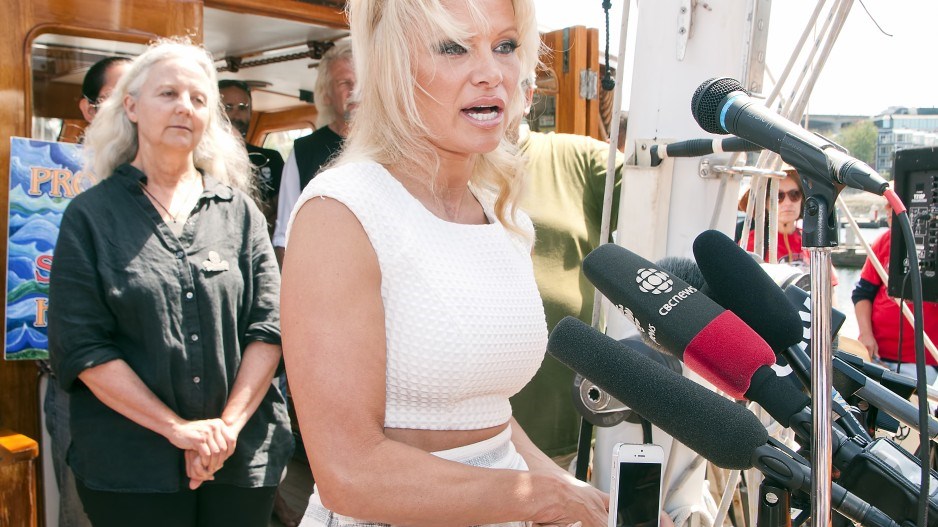At least two First Nations on B.C.’s coast have let the campaigners behind Operation Virus Hunter know they are not welcome in their territories.
On July 18, biologist and anti-fish farm campaigner Alexandra Morton was joined on board the Sea Shepherd’s RV/Martin Sheen by actress Pamela Anderson, David Suzuki and two First Nations spokesmen to announce plans to conduct sampling in an attempt to establish whether a virus found in farmed fish is also present in wild fish.
Morton will be collecting samples looking for the piscine reovirus, which has been associated with a condition called heart and skeletal muscle inflammation (HSMI) in salmon, although no definitive causal link between the virus and the disease has yet been established.
She will try to establish whether there are “hot spots” where the virus is present in the vicinity of fish farms.
Salmon farming in B.C. has created a divide among First Nations, like those in the Fraser Valley watershed, who rely on wild salmon both for food and income, and those in coastal communities that rely on fish farms for year-round jobs.
Ernie Crey, a former fisheries adviser for Sto:lo First Nations, was among the First Nations representatives who joined Morton in support of her campaign earlier this week.
Over the years, he said a number of possible causes for a decline in wild salmon stocks, especially Fraser River sockeye, have been identified – including habitat loss and over-fishing.
But Crey said he is now convinced that Morton’s thesis – that disease from fish farms spreading to wild salmon – is the most compelling one.
“She’s now persuaded me that, of all the things that we can point to that might explain the decline in Fraser River salmon runs, particularly the sockeye, she’s persuaded me that we need to look at the salmon farming industry along this coast,” Crey said. “We need to get to the bottom of the impacts they’re having.”
Chief Robert Chamberlain of the Kwikwasut’inuxw Haxwa’mis on Gilford Island on the North Coast of B.C. echoed Crey’s sentiments and said Morton and the Sea Shepherd were “very much welcome” into his people’s territory.
But it’s not welcome in Tlowitsis territory. The Tlowitsis First Nation in Campbell River has a partnership with Grieg Seafood, one of the Norwegian fish farming companies operating in B.C.
“This partnership is vital to the Tlowitsis being able to be economically sustainable,” Tlowitsis Chief John Smith said in a press release.
Smith said any visitors coming to its traditional territory in Clio Channel needs permission.
“The Sea Shepherd Operation Virus Hunter group are not welcome in our territory,” he said in his release.
The Ahousaht First Nation, which has a partnership with another Norwegian company, Cermaq, likewise has made it clear it doesn’t want the Sea Shepherd in its waters either. Cermaq has a fish farm operation in Clayoquot Sound.
According to the Ha-Shilth-Sa, a Vancouver Island First Nation newspaper, Cermaq is an important employer for Ahousaht people.
Morton told Business in Vancouver there is division among the Ahousaht, and many of its members want her to do the sampling.
“There are binding contracts with part of the leadership of the Ahousaht with this company,” she said. “But the elders and warrior societies and many hereditary chiefs feel differently.”
It appears unlikely that fish farm operators will be cooperating with Morton and the Sea Shepherd. But at this week’s press conference, Morton said some First Nations have offered to provide farm fish samples for testing.
But the main aim of the research will be sampling other marine species to look for piscine reovirus in the wild.
It’s not clear what Morton hopes to find that a $9 million scientific study led by Fisheries and Oceans Canada might miss.
Kristi Miller, a lead scientist on the Strategic Salmon Health Initiative, said the piscine reovirus is just one of 45 pathogens she and her team will be studying in a comprehensive study of both farmed and wild salmon. The study does not include sea lice, which Morton’s studies have concluded can be transmitted from fish farms to wild salmon.
Morton acknowledged the federal study involves some “phenomenal scientists,” including Miller, but questioned federal Fisheries Minister Domic LeBlanc’s recent decision to grant six-year licences to fish farm operators while the jury is still out the impact of fish farms on wild stocks.
Miller said fish scientists are starting to get a good idea of the role disease is playing in wild fish stock mortality. Whether those diseases are naturally occurring or being transmitted from fish farms is the $9-million question.
“Certainly the potential for interactions with cultured fish is part of the question, but it’s not the only question,” Miller said.
Miller is looking at all the pathogens found in farmed fish and wild fish and trying to determine which diseases may have been present before and after contact with fish farms.
One of her recent findings was the detection of HSMI in one fish farm. That disease has no impact on humans who may eat the fish.
The piscine reovirus has been found to be in all fish infected with HSMI, but so far it has not been determined to be the cause of the disease. Some pathogens may be concomitant with diseases, but not causal.
“The problem with that particular disease, with that particular virus, is that we don’t know yet if it can cause disease in Pacific salmon,” Miller said. “There’s a lot of evidence to suggest that it has a role with HSMI development in Atlantic salmon. But whether it even associates with disease in Pacific salmon is a big question mark.”
Scientists in Norway are more confident in stating that the virus does cause HSMI in Atlantic salmon there.




